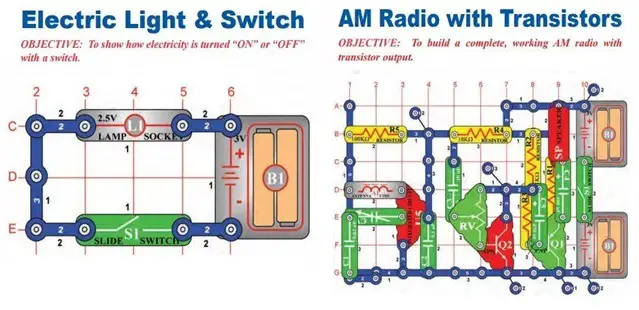
Electronic kits for kids (including electric circuit kits) are specifically designed to teach children the basics of electronics and circuits in a fun and engaging way. These kit include components such as wires, resistors, capacitors, LEDs, switches, and sensors that allow children to experiment with electronic circuits, devices, or projects. They are designed to be safe, easy to use, and age-appropriate for children. Children learn concepts like electricity flow, circuitry, and the behavior of different electronic components.
Everything around us is driven by electronics (and technology) nowadays, and is an important field in the world of engineering. Introducing kids to the world of electronics can help them to move on to more exciting things like computing and robotics projects.
Kids have a curious mind and have always been fascinated with objects (by their movements, colors, design, etc.); most of their toys don’t last long as they try to take them apart (kids do that to most things). As parents, you should definitely encourage children to explore new ideas, and that is where simple machines, electronics kits & toys turn out to be useful learning tools.
Here’s what kids can learn from Electronics (Kits & Toys)
Coordination Skills: Most kits and toys require children to build things, move things, which in turn helps kid develop better hand-eye coordination skills and improve their motor skills.
- Reinforce basic educational fundamentals: Electronic toys and apps teach children about shapes, words, colors, and numbers; they learn more about animals and their world.
- Communication Skills: Not the ones that revolve around human interaction, but the one that is done using technology. After all, much of the communication today happens through technology (instead of in person) – email, social networks, text messaging, phone conversations, video chats, and more.
- Better Research Skills: As children grow and move to the higher classes in school, much of the research happens using technology. Early exposure to electronics & technology makes kids get better at research, a skill that will help them succeed later in their education and their career.
- Creativity: Certain kits and programs can even ignite your child’s creativity – making cars, helicopters, buildings from building blocks. Designing objects, creating animation and logos, adding filters and various effects to photos (using apps), and more.
Recommended Products
There are several toys and kits available that teach electronics to kids in a intuitive manner. For example, Robotics products like Lego Mindstorms where the various electronic components are available as modules that need to be placed together to form a complex product. The modular structure makes it easy for kids to place the various components together and in the process also helps them understand the electronics behind them.
For older kids, you can consider buying popular single-board computer kits such as the Beagleboard, Raspberry Pi, or Arduino.
Another good product is called Snap Circuits, and it serves as an interesting gift as well for kids. Snap Circuits has easy to follow instructions for kids, and the various circuit components snap together very easily like Legos making it easy for kids to assemble the circuits. You can make simple projects (Electric Light with a Switch) and move onto making advanced projects where your kids can start playing with more advanced circuits.
There are several different kits available and we are currently using the SC-300 which comes with 300 projects.
All of these serve as great introduction for kids to electronics. Traditionally electronics classes are also a great way to start building simple circuits with batteries, light bulbs, and motors. However, these kits are highly recommended for kids and is a great way to teach them basics of electronics.
Playz Electrical Circuit Board Engineering Kit
Playz Electrical Circuit Board Engineering Kit for Kids (Age 8+) helps learn about Electricity, Voltage, Currents, Resistance, & Magnetic Science.
With this STEM kit, your child can create your own circuits, you can wire, build, and engineer several exciting electronic experiments, depending on the model you choose. You can also explore your senses with light, sound, and touch controls. It also comes with an instruction manual for assembly and multi-experiments.
Electrician Facts for Kids: What do Electricians do?
An electrician is a skilled person who works with electrical wiring and equipment that power homes & offices. They install, test, and maintain wiring, lighting systems, and fixtures in homes and businesses. Electricians may install new electrical components or fix the ones that are not working.
Their primary work is to fix and repair electrical power in homes, offices, and schools. They use tools such as wire, tape, screwdriver, and power drill. They follow strict safety precautions while worbest king.
Electricians work indoors as well as outdoors, in residential buildings, offices, and factories. They have to work in small places and difficult corners to fix wires. They’re generally paid well for the wok they do.
Electricians have a basic understanding of science (physics) and have good problem-solving skills. Some electricians also have knowledge of alternative energy sources (such as solar panels).
Related: Checkout more best educational STEM toys for kids.
Watch: DIY Electronics Projects for Kids
Electronics for kids (Useful Links)
A fun alien project:
http://blog.arduino.cc/2015/05/18/manipulate-your-voice-with-mimic-monster/
Urge kids to be inventors, not users:
https://blog.adafruit.com/2015/05/19/the-github-for-kids-urges-them-to-be-inventors-not-users-makereducation/
New kind of school in Silicon Valley:
http://www.wired.com/2015/05/altschool/
Funtoyworld is a family-managed website with me (Ben), and my wife doing most of the work. We are proud parents of two wonderful kids and love reviewing toys. We have a firm but friendly “democratic parenting” style and offer several practical suggestions backed by extensive research. Our own experience with raising two children prompted us to share our knowledge. Read more.







Leave a Reply